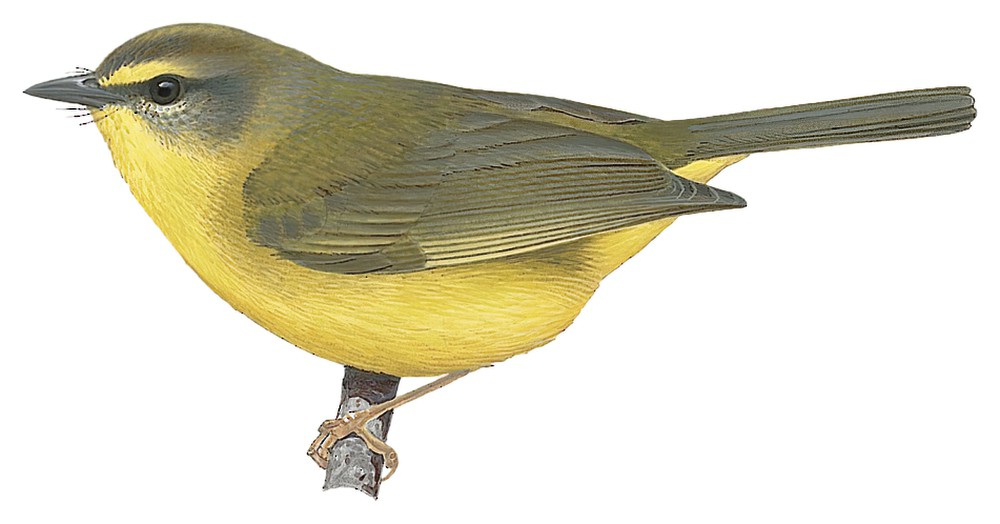Citrine Warbler / Myiothlypis luteoviridis

Citrine Warbler
SCI Name:
Protonym: Trichas luteoviridis AttiSestaRiun.Sci.Ital. p.405
Taxonomy: Passeriformes / Parulidae / Myiothlypis
Taxonomy Code: citwar1
Type Locality: Santa Fe de Bogota, Colombia.
Author: Bonaparte
Publish Year: 1845
IUCN Status:
DEFINITIONS
MYIOTHLYPIS
(Parulidae; Ϯ Black-crested Warbler M. nigrocristata) Gr. μυια muia, μυιας muias fly; θλυπις thlupis unidentified small bird, perhaps some sort of finch or warbler. In ornithology thlypis signifies either a thin-billed tanager or, as in this case, a parulid warbler. "*659. Myiothlypis, Caban. 1850. (Trichas, p. Gr.) America mer. 2. 1. TRICHAS nigricristatus, Lafr. (Setophaga! nigriceps, Licht.) Rev. Zool. 1840. p. 230. ex Bogota. 2. TRICHAS luteo-viridis, Bp. ex Bog. Laete viridis: subtus, cum superciliis antice, luteus. An praecedentis faemina?" (Bonaparte 1850); "Gen. MYIOTHLYPIS nov. gen. *) Fliegen-Waldsänger. 121. 1. M. nigrocristata Nob. — Trichas nigrocristatus Lafr. Rev. Zool. 1840. pag. 230. ... *) Von μυια, Fliege und θλυπις nom. prop. Der in seinem ganzen Verlaufe niedergedrückte fast ganz geradfirstige Schnabel rechtfertigt die generische Trennung von Geothlypis. Bei G. stragulata [= Myiothlypis rivularis] findet sich zwar schon ein merklich breiter, von der typischen Form abweichender Schnabel, jedoch ist derselbe immer noch nach der Spitze hin seitlich zusammengedrückt und mit stärker gebogener Firste." (Cabanis 1853); "Myiothlypis Bonaparte, Consp. Gen. Av., 1, (2), p. 311, end of 1850—type, by subs. desig. (Cabanis, Mus. Hein., 1, p. 17, Oct., 1851 [= 1853]), Trichas nigro-cristatus Lafresnaye." (Hellmayr 1935, XIII, 476).
Synon. Phaeothlypis.
luteoviridis
Mod. L. luteoviridis uranium-green < L. luteus saffron-yellow < lutum saffron; viridis green < virere to be green.
SUBSPECIES
Citrine Warbler (Northern)
SCI Name: Myiothlypis luteoviridis [luteoviridis Group]
MYIOTHLYPIS
(Parulidae; Ϯ Black-crested Warbler M. nigrocristata) Gr. μυια muia, μυιας muias fly; θλυπις thlupis unidentified small bird, perhaps some sort of finch or warbler. In ornithology thlypis signifies either a thin-billed tanager or, as in this case, a parulid warbler. "*659. Myiothlypis, Caban. 1850. (Trichas, p. Gr.) America mer. 2. 1. TRICHAS nigricristatus, Lafr. (Setophaga! nigriceps, Licht.) Rev. Zool. 1840. p. 230. ex Bogota. 2. TRICHAS luteo-viridis, Bp. ex Bog. Laete viridis: subtus, cum superciliis antice, luteus. An praecedentis faemina?" (Bonaparte 1850); "Gen. MYIOTHLYPIS nov. gen. *) Fliegen-Waldsänger. 121. 1. M. nigrocristata Nob. — Trichas nigrocristatus Lafr. Rev. Zool. 1840. pag. 230. ... *) Von μυια, Fliege und θλυπις nom. prop. Der in seinem ganzen Verlaufe niedergedrückte fast ganz geradfirstige Schnabel rechtfertigt die generische Trennung von Geothlypis. Bei G. stragulata [= Myiothlypis rivularis] findet sich zwar schon ein merklich breiter, von der typischen Form abweichender Schnabel, jedoch ist derselbe immer noch nach der Spitze hin seitlich zusammengedrückt und mit stärker gebogener Firste." (Cabanis 1853); "Myiothlypis Bonaparte, Consp. Gen. Av., 1, (2), p. 311, end of 1850—type, by subs. desig. (Cabanis, Mus. Hein., 1, p. 17, Oct., 1851 [= 1853]), Trichas nigro-cristatus Lafresnaye." (Hellmayr 1935, XIII, 476).
Synon. Phaeothlypis.
Citrine Warbler (Peruvian)
SCI Name: Myiothlypis luteoviridis striaticeps
striaticeps
L. striatus striated < striare to striate < stria furrow; –ceps -capped < caput, capitis head.
Citrine Warbler (Bolivian)
SCI Name: Myiothlypis luteoviridis euophrys
euophrys
Gr. ευοφρυς euophrus, ευοφρυος euophruos fine-browed, with fine eyebrows < ευ eu fine; οφρυς ophrus, οφρυος ophruos eyebrow, brow.
UPPERCASE: current genus
Uppercase first letter: generic synonym
● and ● See: generic homonyms
lowercase: species and subspecies
●: early names, variants, mispellings
‡: extinct
†: type species
Gr.: ancient Greek
L.: Latin
<: derived from
syn: synonym of
/: separates historical and modern geographic names
ex: based on
TL: type locality
OD: original diagnosis (genus) or original description (species)












